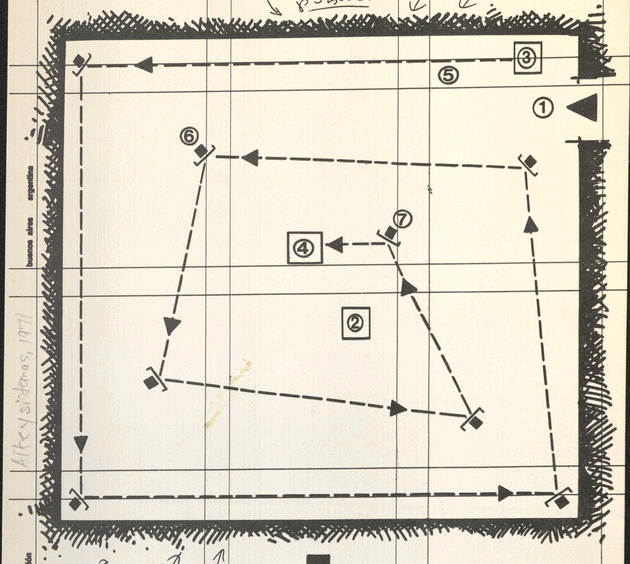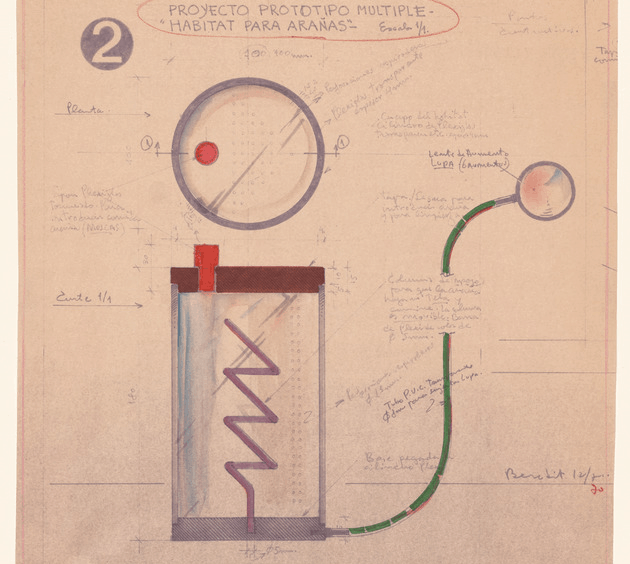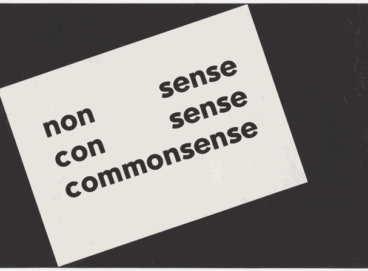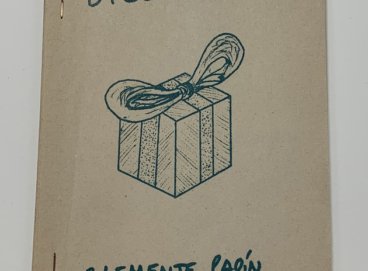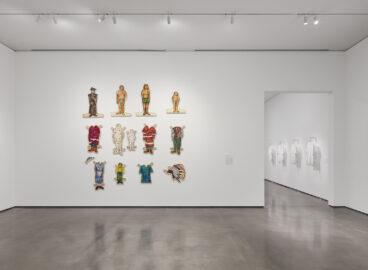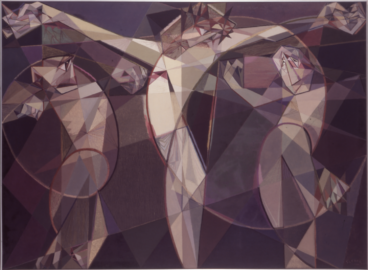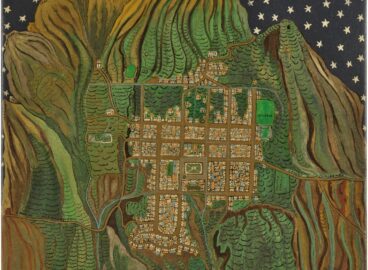In 1972, Argentine artist Luis Fernando Benedit installed a hydroponic greenhouse environment, containing seventy tomato plants and fifty-six lettuce plants artificially supplied with light and a chemical growth formula, as well as an environment for white mice, “consisting of a maze, food source, material for burrowing, and an enclosed area for sleeping,” at MoMA. This essay considers Benedit’s bioart practice––and its conceptions of technology, the museum space and the human and non-human systems unfolding there––within the history of conceptualism in Latin America.
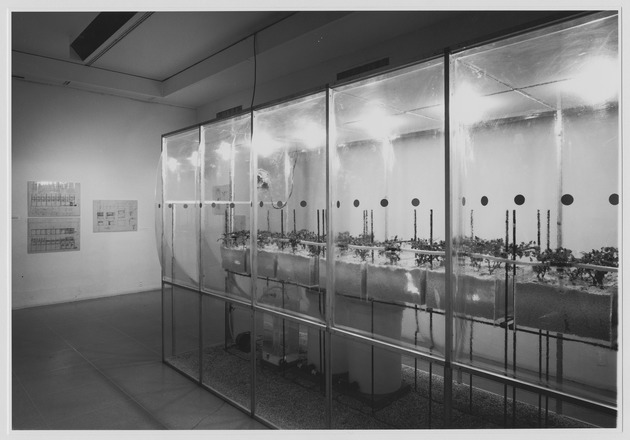
El tema de la vida resurge inagotable: La biología se convierte en arte y el arte, a su vez, en vida.
—Antonio M. Battro1“The theme of life reemerges in an inexhaustible fashion, as biology becomes art and, in turn, art becomes biology.” Antonio M. Battro, “Microzoo,” in Microzoo, by Luis Fernando Benedit (Buenos Aires: Fontana, 1968), 9.
As scholars and critics begin to attend to the role of non-humans in the history of new media art, Argentine artist Luis Fernando Benedit (1937–2011) becomes a necessary reference, both as a pioneer of bioart and as an artist interested in human-animal interactions. In 1970, at the age of thirty-three, Benedit reached the peak of his international exposure, when entrepreneur and curator Jorge Glusberg invited him to participate in the 35th Venice Biennale. Broadly themed around the question of art and technology, this edition of the Venetian show was affected by a sequel of scandals, with more than twenty artists from the United States boycotting the event to protest against the war in Vietnam and Cambodia, and other artists, including Dan Flavin and Michael Heizer, withdrawing their pieces after its chaotic opening.2Paul Hofmann, “35th Art Biennale Beset by Problems at Venice Opening,” New York Times, June 24, 1970, 38. In the midst of such turmoil, it is notable that reviews of the Biennale rarely fail to mention Benedit’s installation in the Argentine pavilion. The piece became a must-see and triggered a range of emotions among spectators, from utter surprise to strong disapproval.3See Enzo Di Martino, The History of the Venice Biennale: 1895–2005 (Venice: Papiro Arte, 2005), 62; and Hofmann, “35th Art Biennale Beset by Problems at Venice Opening.” One dissatisfied critic wrote: “The 35th edition revealed an empty research directed towards a connection between technology and humanism, from a swarm of live bees to a supermarket of mechanical products. A sterile void triumphed there.”4Quoted in Francesca Franco, “The First Computer Art Show at the 1970 Venice Biennale: An Experiment or Product of the Bourgeois Culture?,” in Relive: Media Art Histories, eds. Sean Cubitt and Paul Thomas (Cambridge, MA: MIT Press, 2013), 130.
Benedit was responsible for the “swarm of live bees,” part of a piece entitled Biotrón. A collaborative effort with ethologist Josué Núñez and experimental psychologist Antonio M. Battro, Biotrón aimed at transforming the Biennale’s blasé spectators into amateur researchers of animal behavior. It invited them to observe not objects or figures but life itself, and confronted them with the vibrancy of animal life in an “operative space” designed by the artist.5See the next section of this essay for a description of the meaning of “operative space,” which can be understood in dialogue with Harun Farocki’s notion of the “operative image.” See Farocki, “Phantom Images,” Public 29 (2004): 12–22. Despite the pointed criticisms the piece elicited, the next edition of the Biennale reinforced the value of Benedit’s preoccupations, inviting artists to present works around the theme of art and behavior. This is how, two years after Benedit took bees to Venice, the Belgian collective Mass Moving came to install ten thousand butterfly pupae in a giant incubator in Piazza San Marco and then release them, en masse, when they hatched.6Di Martino, The History of the Venice Biennale, 63. See also Arton Foundation, “The Butterfly Project: Cocoon Incubator, Piazza San Marco, Venice, IT,” Forgotten Heritage (online database), https://www.forgottenheritage.eu/artworks/1294/the-butterfly-project-cocoon-incubator-piazza-san-marco-venice-it. Benedit’s Biotrón seemed to instigate an artistic practice involving the joint agency of animals and humans in the creation of installation art. This practice has been expanded upon and continued in works such as Damian Hirst’s In and Out of Love (1991) and Jeroen Eisinga’s Springtime (2010–11).

Animal Labyrinths
Biotrón featured a beehive with four thousand bees in a “field” of nectar-suppurating artificial flowers. The bees were housed inside a three-meter-high structure of aluminum and transparent Plexiglas, but they could leave this “flight cage” (jaula de vuelo, as the artist called it) through a wide opening in one of the cage’s sides to feed from real flowers in a nearby garden. It has been said that the bees preferred the artificial solution, although the lack of extensive documentation of the piece prevents a precise description.7The Museum of Modern Art, “Projects: Luis Fernando Benedit [. . .],” press release no. 125, November 14, 1972, 2, https://www.moma.org/momaorg/shared/pdfs/docs/ We do know that Biotrón was part of a series of environments for plants and animals that Benedit began developing in the mid-1960s, and which, prior to Venice, he had exhibited in 1968 in Microzoo, a solo show at the Rubens Gallery in Buenos Aires, and Materiales: Nuevas Técnicas, Nuevas Expresiones, a group show at the Museo Nacional de Bellas Artes in Buenos Aires. The series involved both the design and the construction of living environments, or habitáculos, for ants, mice, fish, lizards, tortoises, and plants, among other creatures.8Jorge Glusberg, “Luis Benedit: Las memorias del olvido,” in Luis F. Benedit en el Museo Nacional de Bellas Artes (Buenos Aires: MNBA, 1996), 15–16. The artist, who studied architecture in Buenos Aires and then specialized in landscape architecture in Rome, conceived of these spaces as labyrinths, which he described as the apex of “cultured nature” (naturaleza culta).9Quoted in ibid., 15. He imagined the animals and plants within them developing new behaviors and relationships as a result of their immersion in unusual, human-made environments.
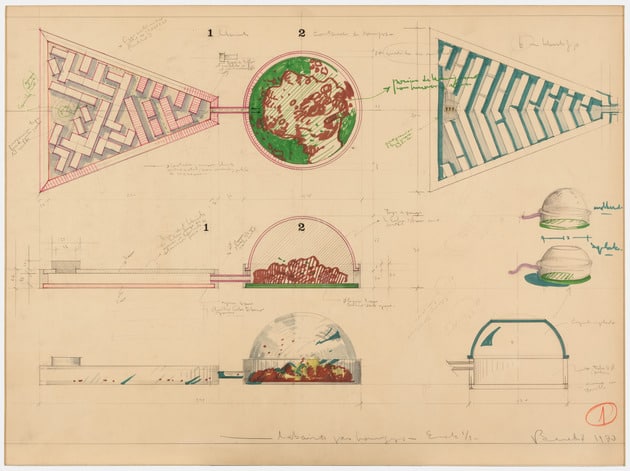
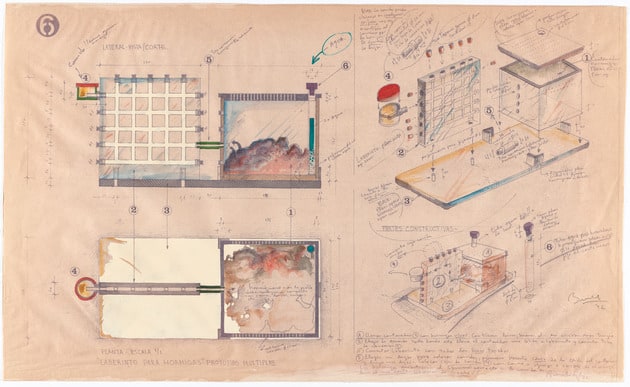
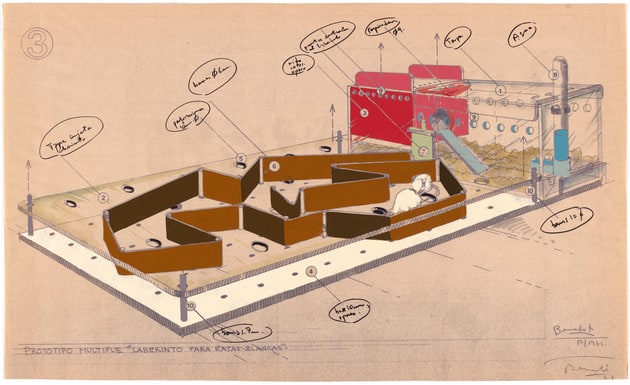
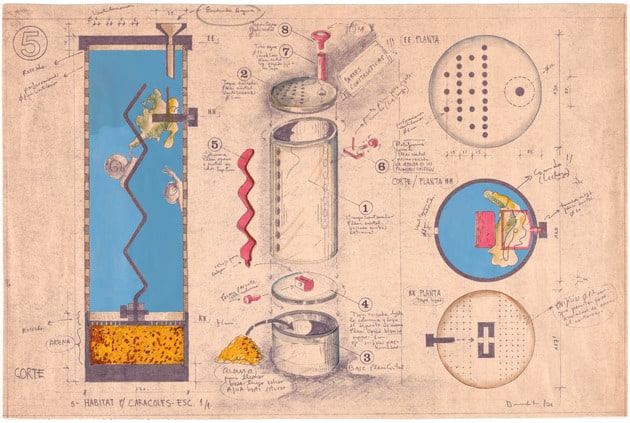
The labyrinth appears here as a complex, often threatening, yet playful structure with operative powers—that is, with the capacity to act upon plants, animals, and humans alike.10This operative capacity or power of space is poignantly expressed in the myth of the Minotaur, in which the labyrinth allows Daedalus to tame a force beyond his (human) control. Crucially, Daedalus, like Benedit, is a craftsman and artist. Concerned with what he perceived as an “oblivion” of nature in the art of the 1960s, Benedit saw this physical space—midway between nature and culture—as disruptive of a strictly humanist view of animal and plant life, a view in which non-humans appear as passive beings whose behavior is both predetermined and narrowly oriented toward simple, repetitive goals. Biotróninvited the public to inquire: Would the bees ultimately choose artifice over nature? Would they seek to escape the labyrinth in which they were trapped? Would observing them within this novel environment teach us something new about their behavior? Would it teach them something new about themselves?
By placing the animal sensorium and the observation of animal life at the center of his creations, Benedit aimed to expand prevalent conceptions of art and aesthetics. However, the convergence of art and biology in Benedit’s work did not operate by simply substituting art objects for animals or plants. Rather its focus was to partake in a larger transformation in artistic practice: a shift from an understanding of art as a static object to an understanding of it as a system and process, a time-based producer of relations involving humans and non-humans alike. Benedit’s interest in animal behavior, the pairing of art and science in his art, and the very possibility of this pairing were therefore part of a profound transformation in the ontology of art, in which previous conceptions of art as a materially specific, finite product would give way to a more dynamic vision of artistic practice, one capable of encompassing the circulation of matter, energy, and information within systems and processes.
The shift from object to process in Latin American art has been the focus of much attention over the past three decades, and lain at the core of ongoing discussions on the rise of Latin American conceptualism. Current historiography on this period attributes its development and rapid dissemination to the ways in which individual artists and artists’ collectives responded to experiences of authoritarianism in the region, often under the influence of the communication strategies of dissident movements resisting these regimes.11See the seminal book by Luis Camnitzer, Conceptualism in Latin American Art: Didactics of Liberation (Austin: University of Texas Press, 2007); and Mari Carmen Ramírez, “Tactics for Thriving on Adversity: Conceptualism in Latin America, 1960–1980,” in Global Conceptualism: Points of Origin, 1950s–1980s, eds. Luis Camnitzer, Jane Farver, and Rachel Weiss (New York: Queens Museum of Art, 1999), 53–71. In these as yet incomplete and complex histories, however, the techno-scientific developments, ideas, and infrastructures of that time have been notoriously absent. The history of art, the history of science and technology, and the history of politics seem to be entirely separate from one another; only art and politics converse. My current research suggests that the sole focus on politics in our attempt to understand the rise of conceptualism in Latin America is insufficient. It is only by also looking at the relationship between techno-science and art that one can truly come to understand the major changes that Latin American art underwent in the late 1960s and 1970s. In this text I aim to present a snapshot of this larger process, looking specifically at Benedit’s labyrinths.
The Museum as an Epistemological Space
In November 1972, Benedit became the first Latin American artist to exhibit in MoMA’s Projects Gallery, with a solo show entitled Projects: Luis Fernando Benedit, curated by Berenice Rose, then Associate Curator of Drawings. The Museum’s press release describes the show as “consisting of two man-made environments for living organisms and a selection of related drawings.”12The Museum of Modern Art, “Projects: Luis Fernando Benedit [. . .].” The first, entitled Phitotron, was a hydroponic greenhouse environment containing seventy tomato plants and fifty-six lettuce plants artificially supplied with light and a chemical growth formula. The second was an environment for white mice, “consisting of a maze, food source, material for burrowing, and an enclosed area for sleeping.”13Ibid. Installed in the centers of what were separate spaces, with the corresponding designs for each piece hung on the walls around them, the environments aimed to enable the public to observe the “growth, change and repetition of the patterns of living organisms over a period of time.”14Ibid.
Benedit’s labyrinths relied on the functional aesthetic of a scientific experiment and re-created the uncannily aseptic atmosphere of a laboratory. This approach to the museum space brings to mind Bruno Latour’s reflections on the laboratory as both an “epistemological and civic”15Tony Bennett, “Civic Laboratories: Museums, Cultural Objecthood and the Governance of the Social,” in South Pacific Museums: Experiments in Culture, eds. Chris Healy and Andrea Witcomb (Melbourne: Monash University, 2006), 8.1. space, one capable of intervening in the social without having to treat objects, beings, and relations as they naturally occur.16As Bennett suggests, “The museum object is . . . always non-identical with itself or with the event (natural, social or cultural) of which it is the trace.” Ibid., 8.5. Phitotron, in particular, takes the then rapidly expanding field of sculpture into the terrain of biology, not by going toward the landscape, as Robert Smithson, Michael Heizer, and others were doing in those years,17See Rosalind Krauss, “Sculpture in the Expanded Field,” October 8 (Spring 1979): 30–44. but rather by bringing the animal and plant worlds into the museum—in this case, by re-creating a hydroponic greenhouse inside MoMA. In Phitotron, therefore, the temporalities, shapes, colors, and growth dynamics of plants entered the white cube not as decoration or as objects of representation but as actants or participants in the making of art.
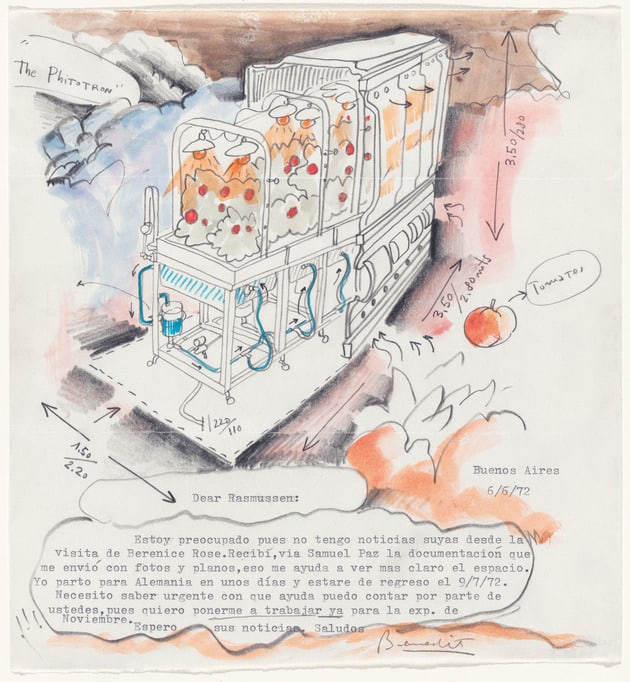
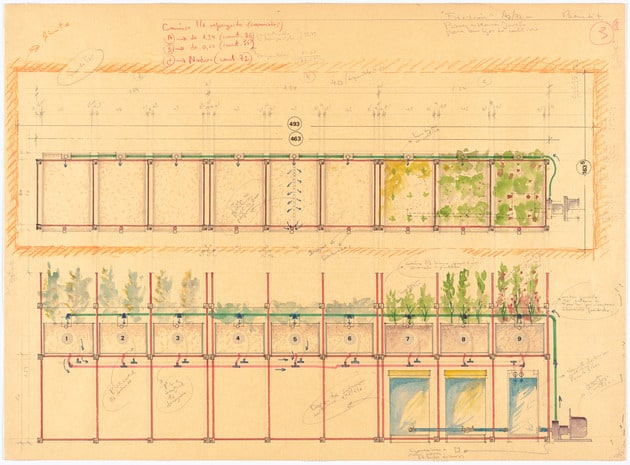
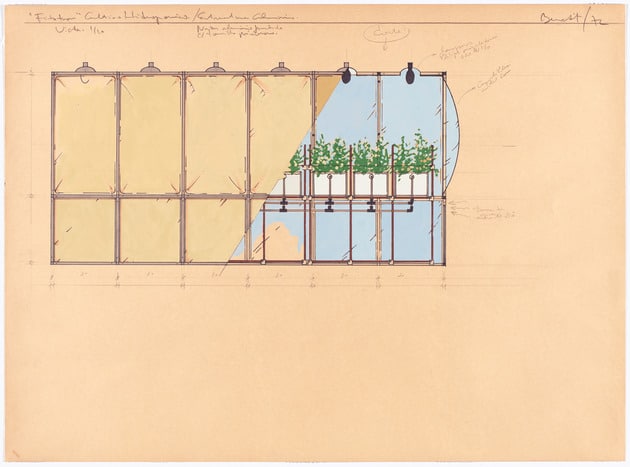

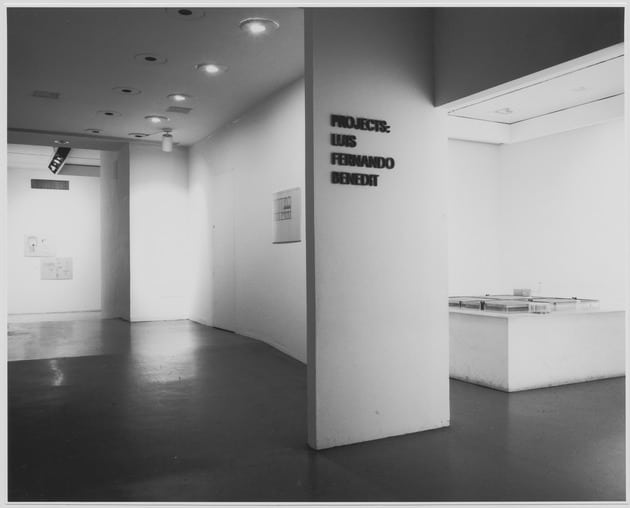
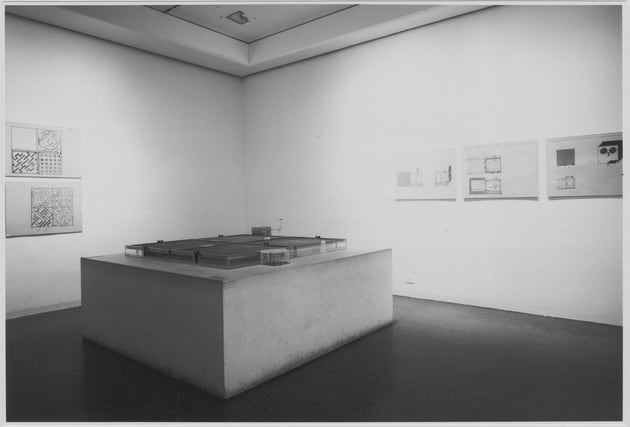
Yet to this I must add that just as Benedit was beginning to recognize and interact with nonhuman forms of agency in the constitution of aesthetic experience, he also affirmed the humanist desire for the control and manipulation of “nature.”18For a discussion on the need to qualify the concept of “nature” in light of its intrinsic anthropocentrism, see Timothy Morton, Ecology without Nature: Rethinking Environmental Aesthetics (Cambridge, MA, and London: Harvard University Press, 2007). For Phitotron entailed not just creating the necessary conditions for the growth of the vegetables but also regulating those conditions, by altering the humidity and light levels inside the phytotron, and inviting spectators to witness the resulting changes. The relatively slow pace of plant growth meant that the temporality of the Phitotron lay midway between the presumed permanency of painting and sculpture and the common acceleration of video and performance art. Moreover, in this piece, plant growth was understood in a singular manner: as resulting from the plants’ embeddedness in a system of relations and information exchange, one in which communication and thought could occur both among humans, and between humans and non-humans, as Norbert Wiener suggests in his seminal book Cybernetics or Control and Communication between the Animal and the Machine(1948).19Norbert Wiener, Cybernetics or Control and Communication in the Animal and the Machine(New York: John Wiley and Sons, 1948).
First published in the 1940s, Wiener’s ideas were rapidly popularized during the following three decades in fields as varied as anthropology, politics, economics, and art. In the leaflet that accompanied Phitotron, Glusberg describes the tomatoes’ and lettuces’ responses to changes in light and humidity using a singular cybernetic jargon or “cyberspeak,” in which ontological distinctions between animals, plants, humans, and machines are displaced by a universal model of information exchange between systems.20Historian of science Slava Gerovitch proposes the notion of “cyberspeak” in his study of cybernetics in the Soviet Union. See Gerovitch, From Newspeak to Cyberspeak: A History of Soviet Cybernetics (Cambridge, MA: MIT Press, 2002). He writes: “When there is an external modification, the organism ‘informs itself about it’ and adecuates [sic] its functioning in accordance. . . . They [the plants] are machines, that is, predictable processes; this shapes them as cybernetic objects. . . . The process which the animal, the vegetable or the human being follows can be predicted.”21Jorge Glusberg, Benedit: Phitotron (New York: The Museum of Modern Art and Centro de Arte y Comunicación, 1972), https://www.moma.org/documents/moma_catalogue
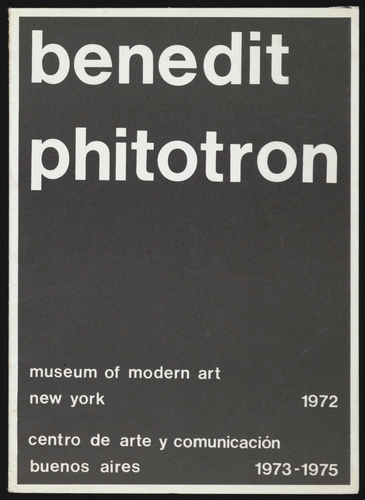

The casting of plants as machines in Glusberg’s discussion of Phitotron echoes earlier attempts at appropriating a cybernetic epistemology in an artistic context. Three key exhibitions paved the way: Cybernetic Serendipity, curated by Jasia Reichardt at the Institute of Contemporary Arts in London in 1968; Glusberg’s own Cybernetics and Art, organized at the Bonino Gallery in Buenos Aires in 1969; and Software: Information Technology: Its New Meaning in Art, curated by Jack Burnham at the Jewish Museum in New York in 1970. Beyond making available a new language to discuss art and the relationships that art triggers and mobilizes, according to Nicolas Schöffer, one of the pioneering artists interested in cybernetics, this science opened the possibility of creating “intelligent” and “liberated” sculptures capable of “offer[ing] to the spectator a spectacle that is always varied and different.”22Quoted in Andreas Broeckmann, “Towards the Art and Aesthetics of the Machine,” in Machine Art in the Twentieth Century (Cambridge, MA: MIT Press, 2016), 97. Art historian Andreas Broeckmann similarly argues that cybernetics brought a new notion of the machine to the field of art, by incorporating the ideas of interactivity and change, and thus setting itself against the “retro” mechanical sculptures of, for instance, Jean Tinguely.23Ibid., 94. For a discussion on the relationship between cybernetics and interactivity and play in Reichardt’s exhibitions Cybernetic Serendipity (ICA, London, 1968) and Play Orbit (curated in collaboration with Peter Jones and first shown in the National Eisteddfod of Wales, then at the ICA, London, in 1969), see Tim Stott, “When Attitudes Became Toys: Jasia Reichardt’s Play Orbit,” Art History 41, no. 2 (April 2018): 344–69.
Change and interactivity shaped Benedit’s interest in forging a new, serendipitous attitude for the reception of his art, one—perhaps counterintuitively—resulting from its intersection with science. Glusberg describes serendipity as “a path in which the investigator does not blindly concentrate on the object of his study, but rather is alert and sensible to any accidental fact which should appear during the course of his work.”24Glusberg, “Luis Benedit: Las memorias del olvido,” 40; Glusberg, Benedit: Phitotron, n.p. Taking his cue from Reichardt’s show, although problematically attributing the term solely to Horace Walpole, Glusberg considered this a necessary aesthetic and reflective approach in the face of the growing complexity of the sciences of the time and the progressively diverse fields of conceptual and postconceptual artistic practice. However, despite Benedit’s success in creating a “laboratory aesthetic with nonhumans” in a modern art museum, and despite the serendipitous attitude that his pieces can trigger in the spectator, critic Arnaud Gerspacher argues that his art fell short of being able to collapse the distinction between animality, humanity, and technicity. In Phitotron, Gerspacher suggests, “nonhuman processes” are little more than “aestheticized forms of experimentation, conditioning, and observation”; in other words, “any natural coupling between science and art has not yet fully arrived.”25Arnaud Gerspacher, “Animal Art (1987) and the Split Origins of Bioart,” in The Routledge Companion to Biology in Art and Architecture, eds. Charissa N Terranova and Meredith Tromble (New York: Routledge, 2017), 328. A different coupling is visibly established nonetheless, one in which the notion of “liveness”—which lies at the core of performance art theory26See Philip Auslander, Liveness: Performance in a Mediatized Culture, 2nd ed. (London and New York: Routledge, 2008).—shifts from the limited sphere of the human to the expanded sphere of the non-human. Like the epigraph to this piece suggests, the theme of life reemerges, as biology becomes art and art becomes biology.


Invisible Labyrinth
In order to grasp the significance of this expanded notion of liveness and its relationship to the cybernetic science of the late 1960s, I wish to conclude this reflection by turning to Laberinto Invisible (Invisible Labyrinth, 1971) the only labyrinth by Benedit in which humans themselves become objects of observation as they respond to nonlinguistic stimuli.27The piece was part of the first Arte de Sistemasexhibition, curated by Glusberg in 1971 at the Museo de Arte Moderno in Buenos Aires. Some scholars have argued that this piece was exhibited at MoMA as part of Benedit’s Projects Gallery show; however, there are no records in the Museum confirming this. The piece involved creating an invisible path that museum visitors were invited to navigate. Motion-sensitive light beams bounced between eight mirrors, leading participants to walk in specific directions, while an alarm bell signaled incorrect choices. Successfully walking through the labyrinth resulted in an unusual reward: the confrontation with a Mexican axolotl, an eerie amphibian creature associated in Aztec mythology with the underworld, and popularized in Argentina through a short story by Julio Cortázar in which a man stares at an axolotl’s lidless “eyes of gold” until he himself becomes one of these creatures.28The short story, entitled “Axolotl,” is part of Julio Cortázar’s 1956 collection Final de juego(Barcelona: Seix Barral, 1975). It is likely that Invisible Labyrinth directly references this well-known story, allegorically bringing the participant back to his or her own animality.



Historian Daniel Quiles describes the piece as a laboratory maze for rats enlarged to human scale.29Daniel Quiles, “Trial and Error: Luis Benedit’s Laberinto Invisible,” Arara 10 (2010): 2. By leaving aside any distinction between human and nonhuman forms of acting and learning, Benedit refrains from subscribing to any notion of human singularity, while adopting instead the universalism of cybernetics. Along these lines, Glusberg argues that the artist’s “frame of reference” in the entire Projects Gallery show was to make a social investigation through animal and vegetable models, creating “a kind of scientific laboratory” for the study of collective behavior within a community.30Glusberg, Benedit: Phitotron, n.p. Each of the two works exhibited, Glusberg adds, “is a model for the universe that substitutes what we usually call the real universe, and proposes a microcosm with its own temporality and space.”31Ibid. The complexity of each of these microcosms is visible in the drawings Benedit made for their design.32MoMA’s Department of Prints and Drawings holds a number of these materials. A selection of them was exhibited in the 2010 show The Modern Myth: Drawing Mythologies in Modern Times. These are not just strikingly detailed and colorful, some of the annotations in them are also particularly telling. There is, for instance, a reference to “postmodern developmentalism” in the artist’s 1971 Study for “Proyecto Prototipo Multiple,” which he also cynically referred to as a “pecera para peces tropicales” (tank for tropical fish). Looking at these drawings alongside the finished pieces—as the Projects Gallery exhibition invited the spectator to do—offers an entirely new dimension to Benedit’s approach to cybernetics. It suggests that cybernetics was for the artist more than a science to be invoked, illustrated, celebrated. Cybernetics was also a scientific paradigm to be critiqued, the route to a biopolitics that could lead to the control of humans, animals, and plants alike through seemingly invisible yet powerful systems of control. As the artist’s annotations advance, such systems would not remain invisible to authoritarian leaders in “tropical” Latin America and beyond. Thus the need to understand them and, ultimately, subvert them—through play, serendipity, wit.
- 1“The theme of life reemerges in an inexhaustible fashion, as biology becomes art and, in turn, art becomes biology.” Antonio M. Battro, “Microzoo,” in Microzoo, by Luis Fernando Benedit (Buenos Aires: Fontana, 1968), 9.
- 2Paul Hofmann, “35th Art Biennale Beset by Problems at Venice Opening,” New York Times, June 24, 1970, 38.
- 3See Enzo Di Martino, The History of the Venice Biennale: 1895–2005 (Venice: Papiro Arte, 2005), 62; and Hofmann, “35th Art Biennale Beset by Problems at Venice Opening.”
- 4Quoted in Francesca Franco, “The First Computer Art Show at the 1970 Venice Biennale: An Experiment or Product of the Bourgeois Culture?,” in Relive: Media Art Histories, eds. Sean Cubitt and Paul Thomas (Cambridge, MA: MIT Press, 2013), 130.
- 5See the next section of this essay for a description of the meaning of “operative space,” which can be understood in dialogue with Harun Farocki’s notion of the “operative image.” See Farocki, “Phantom Images,” Public 29 (2004): 12–22.
- 6Di Martino, The History of the Venice Biennale, 63. See also Arton Foundation, “The Butterfly Project: Cocoon Incubator, Piazza San Marco, Venice, IT,” Forgotten Heritage (online database), https://www.forgottenheritage.eu/artworks/1294/the-butterfly-project-cocoon-incubator-piazza-san-marco-venice-it.
- 7The Museum of Modern Art, “Projects: Luis Fernando Benedit [. . .],” press release no. 125, November 14, 1972, 2, https://www.moma.org/momaorg/shared/pdfs/docs/
- 8Jorge Glusberg, “Luis Benedit: Las memorias del olvido,” in Luis F. Benedit en el Museo Nacional de Bellas Artes (Buenos Aires: MNBA, 1996), 15–16.
- 9Quoted in ibid., 15.
- 10This operative capacity or power of space is poignantly expressed in the myth of the Minotaur, in which the labyrinth allows Daedalus to tame a force beyond his (human) control. Crucially, Daedalus, like Benedit, is a craftsman and artist.
- 11See the seminal book by Luis Camnitzer, Conceptualism in Latin American Art: Didactics of Liberation (Austin: University of Texas Press, 2007); and Mari Carmen Ramírez, “Tactics for Thriving on Adversity: Conceptualism in Latin America, 1960–1980,” in Global Conceptualism: Points of Origin, 1950s–1980s, eds. Luis Camnitzer, Jane Farver, and Rachel Weiss (New York: Queens Museum of Art, 1999), 53–71.
- 12The Museum of Modern Art, “Projects: Luis Fernando Benedit [. . .].”
- 13Ibid.
- 14Ibid.
- 15Tony Bennett, “Civic Laboratories: Museums, Cultural Objecthood and the Governance of the Social,” in South Pacific Museums: Experiments in Culture, eds. Chris Healy and Andrea Witcomb (Melbourne: Monash University, 2006), 8.1.
- 16As Bennett suggests, “The museum object is . . . always non-identical with itself or with the event (natural, social or cultural) of which it is the trace.” Ibid., 8.5.
- 17See Rosalind Krauss, “Sculpture in the Expanded Field,” October 8 (Spring 1979): 30–44.
- 18For a discussion on the need to qualify the concept of “nature” in light of its intrinsic anthropocentrism, see Timothy Morton, Ecology without Nature: Rethinking Environmental Aesthetics (Cambridge, MA, and London: Harvard University Press, 2007).
- 19Norbert Wiener, Cybernetics or Control and Communication in the Animal and the Machine(New York: John Wiley and Sons, 1948).
- 20Historian of science Slava Gerovitch proposes the notion of “cyberspeak” in his study of cybernetics in the Soviet Union. See Gerovitch, From Newspeak to Cyberspeak: A History of Soviet Cybernetics (Cambridge, MA: MIT Press, 2002).
- 21Jorge Glusberg, Benedit: Phitotron (New York: The Museum of Modern Art and Centro de Arte y Comunicación, 1972), https://www.moma.org/documents/moma_catalogue
- 22Quoted in Andreas Broeckmann, “Towards the Art and Aesthetics of the Machine,” in Machine Art in the Twentieth Century (Cambridge, MA: MIT Press, 2016), 97.
- 23Ibid., 94. For a discussion on the relationship between cybernetics and interactivity and play in Reichardt’s exhibitions Cybernetic Serendipity (ICA, London, 1968) and Play Orbit (curated in collaboration with Peter Jones and first shown in the National Eisteddfod of Wales, then at the ICA, London, in 1969), see Tim Stott, “When Attitudes Became Toys: Jasia Reichardt’s Play Orbit,” Art History 41, no. 2 (April 2018): 344–69.
- 24Glusberg, “Luis Benedit: Las memorias del olvido,” 40; Glusberg, Benedit: Phitotron, n.p.
- 25Arnaud Gerspacher, “Animal Art (1987) and the Split Origins of Bioart,” in The Routledge Companion to Biology in Art and Architecture, eds. Charissa N Terranova and Meredith Tromble (New York: Routledge, 2017), 328.
- 26See Philip Auslander, Liveness: Performance in a Mediatized Culture, 2nd ed. (London and New York: Routledge, 2008).
- 27The piece was part of the first Arte de Sistemasexhibition, curated by Glusberg in 1971 at the Museo de Arte Moderno in Buenos Aires. Some scholars have argued that this piece was exhibited at MoMA as part of Benedit’s Projects Gallery show; however, there are no records in the Museum confirming this.
- 28The short story, entitled “Axolotl,” is part of Julio Cortázar’s 1956 collection Final de juego(Barcelona: Seix Barral, 1975).
- 29Daniel Quiles, “Trial and Error: Luis Benedit’s Laberinto Invisible,” Arara 10 (2010): 2.
- 30Glusberg, Benedit: Phitotron, n.p.
- 31Ibid.
- 32MoMA’s Department of Prints and Drawings holds a number of these materials. A selection of them was exhibited in the 2010 show The Modern Myth: Drawing Mythologies in Modern Times.
